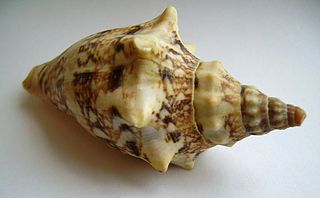
Sir James Hector FRS FRSE(16 March 1834 – 6 November 1907) was a Scottish geologist, naturalist, and surgeon who accompanied the Palliser Expedition as a surgeon and geologist. He went on to have a lengthy career as a government employed man of science in New Zealand, and during this period he dominated the Colony's scientific institutions in a way that no single man has since.

The Museum of New Zealand Te Papa Tongarewa is New Zealand's national museum, located in Wellington. Known as Te Papa, or 'Our Place', it opened in 1998 after the merging of the National Museum and the National Art Gallery. More than 1.5 million people visit every year.

Echyridella menziesii, the New Zealand freshwater mussel, also known by its Māori names kākahi, kāeo, and torewai, is a species of freshwater mussel endemic to New Zealand. E. menziesii is an aquatic bivalve mollusc in the family Unionidae, the river mussels.

A patu is a club or pounder used by the Māori. The word patu in the Māori language means to strike, hit, beat, kill or subdue.

Penion cuvierianus is a species of very large predatory sea snail or whelk, commonly called the flaring penion, a marine gastropod mollusc in the family Buccinidae, the true whelks.

Kurī is the Māori name for the extinct Polynesian dog. It was introduced to New Zealand by the Polynesian ancestors of the Māori during their migration from East Polynesia in the 13th century AD. According to Māori tradition, the demigod Māui transformed his brother-in-law Irawaru into the first dog.

Alcithoe arabica, common name Arabic volute, is a species of very large sea snail, a marine gastropod mollusc in the family Volutidae, the volutes.
Alcithoe wilsonae is a species of rare large sea snail, a marine gastropod mollusc in the family Volutidae, the volutes.

Māori traditional textiles are the indigenous textiles of the Māori people of New Zealand. The organisation Te Roopu Raranga Whatu o Aotearoa, the national Māori weavers' collective, aims to preserve and foster the skills of making and using these materials.

The ʻAhu ʻula, and the mahiole were symbols of the highest rank of the chiefly aliʻi class of ancient Hawaii. The feathered cloaks and capes were believed to provide spiritual protection for Hawaiian chiefs. There are over 160 examples of this traditional clothing in museums around the world. At least six of these cloaks were collected during the voyages of Captain Cook. These cloaks are made from a woven netting decorated with bird feathers and are examples of fine featherwork techniques. One of these cloaks was included in a painting of Cook's death by Johann Zoffany.

Antarctoneptunea benthicola is a species of small-to-medium-sized predatory sea snail or whelk, a marine gastropod mollusc in the family Buccinidae, the true whelks.

Penion ormesi is a species of very large predatory sea snail or whelk, a marine gastropod mollusc in the family Buccinidae, the true whelks.

Divarilima is a genus of marine bivalve molluscs in the family Limidae, the file shells or file clams.

Hawaiian feather helmets, known as mahiole in the Hawaiian language, were worn with feather cloaks. These were symbols of the highest rank reserved for the men of the aliʻi, the chiefly class of Hawaii. There are examples of this traditional headgear in museums around the world. At least sixteen of these helmets were collected during the voyages of Captain Cook. These helmets are made from a woven frame structure decorated with bird feathers and are examples of fine featherwork techniques. One of these helmets was included in a painting of Cook's death by Johann Zoffany.
Alan Preston is a New Zealand jeweller, born in Te Awamutu in 1941.
Jacqueline Fraser is a New Zealand artist of Ngāi Tahu descent.

Rongomaraeroa is the marae of the Museum of New Zealand Te Papa Tongarewa and incorporates a contemporary wharenui [meeting house] Te Hono ki Hawaiki. It is located on the museum's 4th floor overlooking Wellington harbour, and was officially opened on 30 November 1997.
Marion Elizabeth Tylee was a New Zealand artist.

Pounamu or greenstone are terms for several types of hard and durable stone found in southern New Zealand. They are highly valued in New Zealand, and carvings made from pounamu play an important role in Māori culture.














